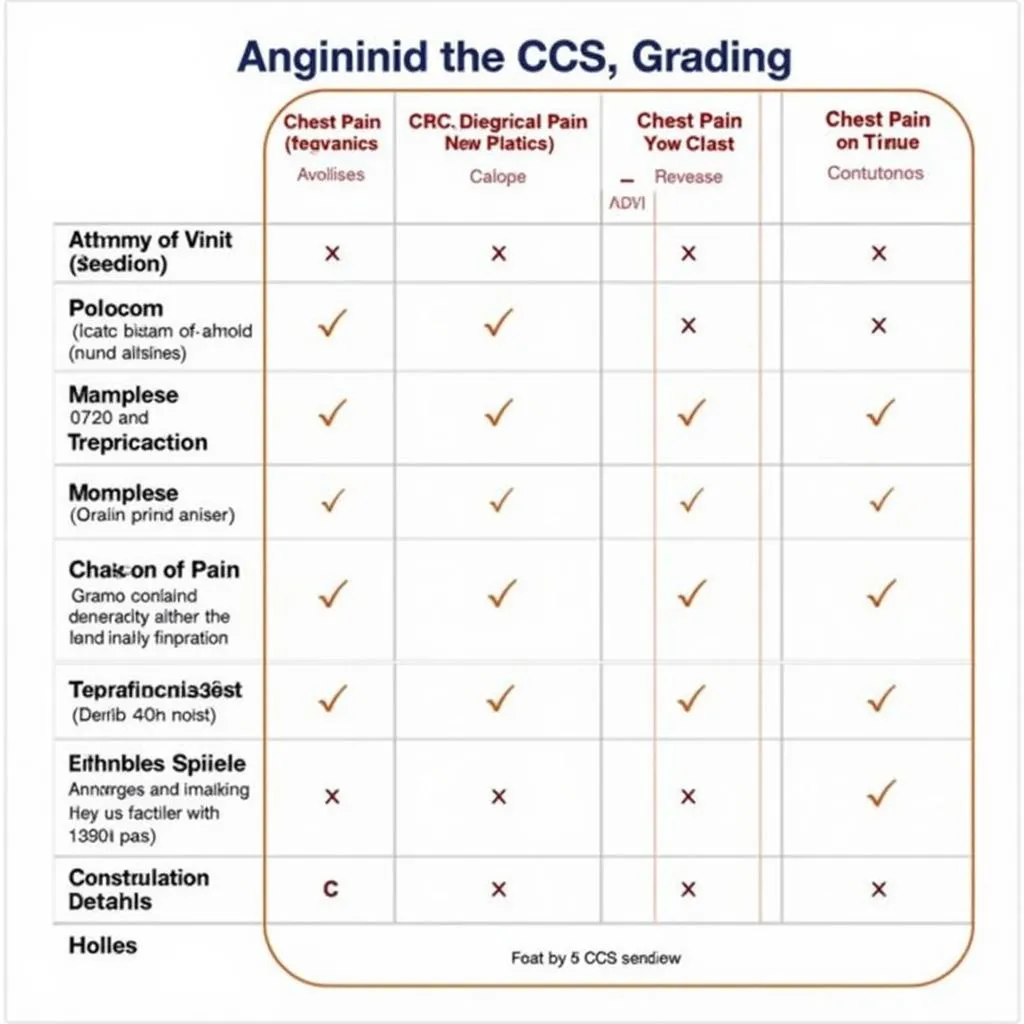Angina pectoris, a common symptom of coronary artery disease, is characterized by chest pain or discomfort caused by reduced blood flow to the heart muscle. The Canadian Cardiovascular Society (CCS) grading system is widely used to classify the severity of angina, providing valuable information for patient management and treatment decisions.
This article will delve into the CCS grading of angina pectoris, exploring its various stages, diagnostic criteria, and clinical implications.
Understanding the CCS Grading System
The CCS grading system categorizes angina into four distinct classes, ranging from mild to severe. Each class is defined by the intensity, frequency, and precipitating factors of the chest pain.
CCS Class I Angina
Mild Angina: CCS Class I angina is characterized by chest pain that occurs only during strenuous physical activity. The pain typically resolves quickly with rest. For example, an individual with CCS Class I angina might experience chest discomfort only during vigorous exercise like running or climbing stairs.
“CCS Class I angina is the mildest form of angina,” explains Dr. Emily Carter, a cardiologist specializing in coronary artery disease. “Patients often report chest pain that occurs only during intense physical exertion and quickly subsides with rest.”
CCS Class II Angina
Moderate Angina: CCS Class II angina occurs with moderate physical exertion. The pain may also occur during everyday activities such as walking briskly or carrying heavy objects. The pain typically subsides within a few minutes of rest.
“CCS Class II angina is more frequent than Class I, occurring with less vigorous physical activity,” states Dr. Carter. “Patients might experience chest pain while walking uphill or climbing stairs.”
CCS Class III Angina
Severe Angina: CCS Class III angina occurs with minimal physical exertion or even at rest. The pain is often severe and may persist for several minutes. The pain can significantly limit daily activities and often requires immediate medical attention.
“Patients with CCS Class III angina experience chest pain with minimal exertion or even at rest,” explains Dr. Carter. “This can greatly impact their daily lives, making even simple tasks like walking or showering challenging.”
CCS Class IV Angina
Unstable Angina: CCS Class IV angina is a severe form of angina that can occur at any time, even at rest. The pain is usually persistent and may not be relieved by rest or medication. This class of angina requires immediate medical attention as it often signals a heart attack or other serious cardiac event.
“CCS Class IV angina is the most severe form, requiring immediate medical intervention,” emphasizes Dr. Carter. “Patients with this class experience persistent chest pain, often accompanied by other symptoms like nausea, sweating, and shortness of breath, indicating a medical emergency.”
Clinical Significance of CCS Grading
The CCS grading system provides crucial information for healthcare professionals in managing angina patients. It allows for:
- Accurate diagnosis: The CCS grading helps physicians diagnose the severity of angina, enabling appropriate treatment planning.
- Prognosis estimation: The CCS grade provides insight into the patient’s long-term risk of cardiac events and helps estimate the effectiveness of treatment.
- Treatment planning: The CCS grading guides treatment options, including lifestyle modifications, medication, and surgical interventions.
FAQs:
1. What are the symptoms of angina pectoris?
Angina pectoris is characterized by chest pain or discomfort that can radiate to other areas, such as the jaw, neck, arms, or back. The pain may be described as a tightness, pressure, squeezing, or burning sensation.
2. What causes angina pectoris?
Angina pectoris is usually caused by a narrowing of the coronary arteries, which supply blood to the heart muscle. This narrowing is often due to atherosclerosis, a buildup of plaque within the arteries.
3. How is angina pectoris diagnosed?
Angina pectoris is typically diagnosed based on a patient’s medical history, physical examination, and various diagnostic tests, including electrocardiogram (ECG), stress test, and coronary angiography.
4. How is angina pectoris treated?
The treatment for angina pectoris depends on the severity and underlying cause. It may include lifestyle modifications such as diet changes and regular exercise, medication such as nitrates, beta-blockers, and calcium channel blockers, or surgical interventions like coronary artery bypass surgery or percutaneous coronary intervention (PCI).
5. Is angina pectoris a serious condition?
Angina pectoris is a serious condition that should be treated promptly. While it is not a heart attack, it can be a warning sign of underlying heart disease and can lead to more severe complications if left untreated.
6. What are some risk factors for angina pectoris?
Some of the risk factors for angina pectoris include high cholesterol, high blood pressure, smoking, diabetes, obesity, and family history of heart disease.
7. Can angina pectoris be prevented?
While some risk factors for angina pectoris are genetic, many can be modified. Making healthy lifestyle choices such as eating a balanced diet, exercising regularly, maintaining a healthy weight, and quitting smoking can help prevent angina pectoris.
 CCS Grading Chart: Understanding Angina Severity
CCS Grading Chart: Understanding Angina Severity
Conclusion
The Canadian Cardiovascular Society grading system provides a standardized and comprehensive approach to classifying the severity of angina pectoris. Understanding this grading system is essential for patients and healthcare professionals alike, as it facilitates accurate diagnosis, prognosis estimation, and personalized treatment planning. Recognizing the symptoms of angina and seeking timely medical attention is crucial in managing this condition and reducing the risk of severe cardiac events.